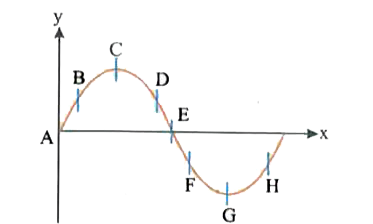Consider two waves passing through the same string. Principle of superposition for displacement says that the net displacement of a particle on the string is sum of the displacements produced by the two waves individually. Suppose we state similar principles for the net velocity of the particle and the net kinetic energy of the particle. Such a principle will be valid fora both the velocity and the kinetic energyb the velocity but not for the kinetic energyc the kinetic energy but not for the velocityd neither the velocity nor the kinetic energy.
b the velocity but not for the kinetic energyEXPLANATION: In the principle of superposition for displacement of a particle the net displacement of a particle is the sum of displacements produced by two waves. Since the displacements are vectors they are added as vectors. The velocity is also a vector hence in a similar principle of superposition it can be added vectorially. But the kinetic energy is a scalar quantity and it cannot be added in a similar way. Simply adding the K.E.s will result in other fallacy. Hence option b.
Related Solutions
Consider two waves passing through the same string. Principle of superposition for displacement says that the net displacement of a particle on the string is sum of the displacements produced by the two waves individually. Suppose we state similar principles for the net velocity of the particle and the net kinetic energy of the particle. Such a principle willl be valid for
View SolutionConsider two waves passing through the same string. Principle of superposition for displacement says that the net displacement of a particle on the string is sum of the displacements produced by the two waves individually. Suppose we state similar principles for the net velocity of the particle and the net kinetic energy of the particle. Such a principle willl be valid for
View Solutionएक डोरी में जाती दो तरंगों के कारण किसी कण के विस्थापन के लिए अध्यारोपण का सिद्धांत काम करता है । ऐसा ही सिद्धांत यदि हम कण के वेग तथा गतिज ऊर्जा के अध्यारोपण के लिए भी लिखे, तो वह सही होगा
View SolutionStatement-1: Two particles acted by same net force for same time always have same change in kinetic energy. Statement-2: Two particles acted by same net force having same displacement always have same change in kinetic energy.
View SolutionStatement-1: Two particles acted by same net force for same time always have same kinetic energy
Statement-2: Two particles acted by same net force having same displacement always have same kinetic energy.
View SolutionAccording to a principle, at a particular point in a medium, the resultant displacement produced by a number of waves is the vector sum of the displacements produced by each of the waves. Name the principle.
View SolutionIn which of the graphs both net displacement and velocity are negative ?
View SolutionA series of pulses, each of amplitude 0.150 m , are sent on a string that is attached to a wall at one end. The pulses are reflected at the wall and travel back along the string without loss of amplitude. When two waves are present on the same string. The net displacement of a given point is the sum of the displacement of the individuals waves at the point. What is the net displacement at point on the spring where two pulses am crossing, (a) if the string is rigidly attached to the post? (b) if the end at which reflection occurs is free is slide up and down ?
View SolutionA series of pulses, each of amplitude , are sent on a string that is attached to a wall at one end. The pulses are reflected at the wall and travel back along the string without loss of amplitude. When two waves are present on the same string. The net displacement of a given point is the sum of the displacement of the individuals waves at the point. What is the net displacement at point on the spring where two pulses am crossing, (a) if the string is rigidly attached to the post? (b) if the end at which reflection occurs is free is slide up and down ?
View SolutionSpeed of a Transverse Wave on Stretched String|The Principle of Superposition of Waves
View SolutionRelation between Velocity OF particle|| Velocity OF wave || Slope OF string || Relation between according to particle & curvature || Velocity OF wave on a string || Examples on string velocity
View SolutionIf the maximum particle velocity is 3 times the wave velocity of a transverse wave of displacement amplitude 'a'. Then the phase difference between two particles separated by (pia)/(2) is
View SolutionA travelling wave has the frequency and the particle displacement amplitude . For the wave the particle velocity amplitude is ………………… and the particle acceleration amplitude is ……………………..
View SolutionA travelling wave has the frequency upsilon and the particle displacement amplitude A . For the wave the particle velocity amplitude is ………………… and the particle acceleration amplitude is ……………………..
View SolutionA travelling wave has the frequency and the particle displacement amplitude . For the wave the particle velocity amplitude is ………………… and the particle acceleration amplitude is ……………………..
View SolutionA transverse wave is travelling along a string from left to right. The figure below represents the shape of the string at a given instant. At this instant the points have an upward velocity are (here X-wave displacement, Y- particle displacement)

View SolutionState the principle of superposition of waves.
View SolutionState the principle of superposition of waves.
View SolutionThe slope of kinetic energy displacement curve of a particle in motion is
View SolutionThe slope of kinetic energy displacement curve of a particle in motion is
View Solution